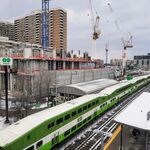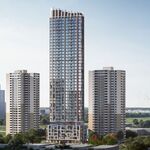An interesting article today in the Financial Post on the U.S. real estate market. Despite the bubble and recession, it looks like there is actually an increase in the number of new luxury homes, greater than 3000 sq.ft. in certain markets.
http://business.financialpost.com/2...zed-luxury-homes-defy-struggling-u-s-economy/
New crop of super-sized, luxury homes defy struggling U.S. economy
Frank Bass, Bloomberg News Jul 13, 2012 – 12:59 PM ET
Even as the U.S. economy struggles to rebound from the worst recession since the Great Depression, Americans are living larger.
Larger, as in larger homes: two-story foyers, twin front staircases, children’s wings, dedicated man caves, coffee bars, four-car garages, and bedroom closets large enough for a fifth vehicle.
Why not go bigger if you can afford it?
The percentage of new single-family homes greater than 3,000 square feet has grown by one-third in the last decade, according to data released last month by the U.S. Census Bureau. The increase has occurred even while 4.3 million homes have been foreclosed upon since January 2007, a result of the housing- bubble collapse and economic meltdown. Slightly more than 1 in 4 new homes built last year were larger than 3,000 square feet, the highest percentage since 2007.
“It’s about opportunity,†Jack McCabe, chief executive officer of Deerfield Beach, Florida-based McCabe Research and Consulting, said in a telephone interview. “It’s about interest rates. And it’s about short memories.â€
On a slight rise above Randolph, New Jersey, Toll Brothers Inc. is building a subdivision with 25 homes, each on 2.5-acre lots. Houses in Randolph Ridge start at US$800,000, with some going for more than twice that amount. The township, halfway between New York City and the Pennsylvania border, is part of Morris County, where about 50 of the nation’s Fortune 500 companies are headquartered or have facilities.
Classic Exurb
Randolph is the classic American exurb, with no real town centre and one main state road lined with car dealerships and chain retail stores. Sport utility vehicle-driving consumers arrive in front of shops along Route 10 with the grim intensity of Marines charging into battle. The town’s Wikipedia profile waits until the fourth word to use the adjective “affluent.â€
“Our customers generally are very successful people,†said Christopher Gaffney, a group president for Toll Brothers, a Horsham, Pennsylvania-based luxury home builder. “These people are very sophisticated buyers, and they know exactly what they want.â€
What they want, apparently, includes a 7,400-square-foot Georgian home that has a five-zone air-conditioning system, five furnaces and a master-bedroom closet with the approximate dimensions of a Manhattan studio apartment. With an unfinished basement, the four-bedroom model home sells for almost US$1.7-million.
Super-Sized
The new crop of super-sized houses are sprouting after the average sales price for a new home dropped to US$267,900 last year from US$292,600 in 2008.
The Census Bureau reports that the average size of a U.S. house rose in 2011 to 2,480 square feet, up from 2,392 square feet in 2010. The 2011 figure is 62.6% larger than the 1,525-square-foot average size in 1973.
Gaffney strolls through the model in Randolph, showing off the small touches: A counter specifically for laptops in the kitchen, in case there’s not enough room on the sprawling granite island or next to the coffee bar. A farm-style sink, deep enough to bathe a medium-sized toddler. Separate bathrooms for each bedroom. And an upstairs playroom with enough counter and shelf space for a high school science lab.
Demand for large, luxury homes began dropping in September 2005, Gaffney said, right after Hurricane Katrina ravaged the Gulf Coast. Since then, it’s been an up-and-down cycle. Did he ever worry that the American love affair with large homes would end? Gaffney processes the question in a millisecond.
“No,†he said. “It was just a matter of when things would turn around, not if. People got tired of putting their lives on hold.â€
Home Sales Fall
To a large extent, people are still putting off new homes. The number of new single-family dwellings built last year fell to 447,000, off 72.9% from the 2006 high of 1.65 million. About 236,000 of the new ones, or more than half, were built in the South.
The largest percentage of homes bigger than 3,000 square feet, 29 percent, was also built in the South. The second- largest percentage of big houses was in the Northeast, where 27% of the 44,000 new homes were larger than 3,000 square feet.
“They think they need it because the people they compare themselves with are upscaling or expanding,†Juliet Schor, a Boston University sociologist and the author of “The Overspent American: Why We Want What We Don’t Need,†wrote in an e-mail. “There’s so much money at the top, they have to spend it in some way.â€
‘Arms Race’
The behaviour of wealthier households can have an adverse effect on less-wealthy people, Robert Frank, a Cornell University economist, wrote in an e-mail, describing the phenomenon as a “positional arms race.â€
“Additional spending by the rich shifts the frame of reference that defines what the near-rich consider necessary or desirable, so they too spend more,†he wrote in an American Prospect article, “Post-Consumer Prosperity.â€
“Such expenditure cascades help explain why the median new house built in the U.S. is now about 50% larger than its counterpart from 30 years ago, even though the median real wage has risen little since then,†Frank wrote.
Danny Jong, a New York commercial and residential real estate investor, had other issues in mind when he visited Randolph Ridge. Jong, who currently lives in Parsippany, needed a place for his mother and the children that he and his wife would like to have.
‘Go Bigger’
“I grew up in a big house,†said Jong, 41, who was raised in northern New Jersey. “Why not go bigger if you can afford it?â€
He said he’s not sure what he’ll do with all the space in his Randolph home, though a live-in housekeeper will take up some room. He said Toll Brothers’ reputation for quality, low interest rates, price per square foot and proximity to s New York office influenced his family’s decision.
“I’ll also have a man cave,†he said. “That was something I really wanted.â€
~~~




